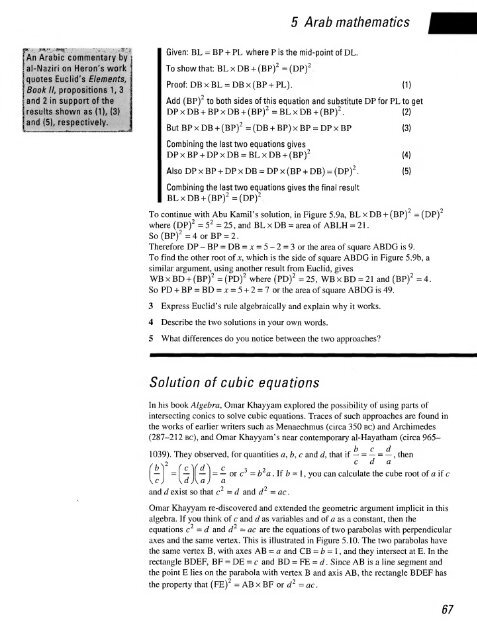history of mathematics - National STEM Centre
history of mathematics - National STEM Centre
history of mathematics - National STEM Centre
You also want an ePaper? Increase the reach of your titles
YUMPU automatically turns print PDFs into web optimized ePapers that Google loves.
An Arabic commentary by<br />
al-Naziri on Heron's work<br />
quotes Euclid's Elements,<br />
Book II, propositions 1, 3<br />
and 2 in support <strong>of</strong> the<br />
results shown as (1), (3) ,„<br />
and (5), respectively. Jjjj<br />
5 Arab <strong>mathematics</strong><br />
Given: BL = BP + PL where P is the mid-point <strong>of</strong> DL.<br />
To show that: BL x DB + (BP) 2 = (DP) 2<br />
Pro<strong>of</strong>: DB x BL = DB x (BP + PL). (1)<br />
Add (BP) 2 to both sides <strong>of</strong> this equation and substitute DP for PL to get<br />
DP x DB + BP x DB + (BP) = BL x DB + (BP) 2 .<br />
(2)<br />
But BP x DB + (BP) 2 = (DB + BP) x BP = DP x BP<br />
Combining the last two equations gives<br />
DP x BP + DP x DB = BL x DB + (BP) 2<br />
Also DP x BP + DP x DB = DP x (BP + DB) = (DP) 2 .<br />
Combining the last two equations gives the final result<br />
BLxDB + (BP) 2 =(DP) 2<br />
To continue with Abu Kamil's solution, in Figure 5.9a, BL x DB + (BP) 2 = (DP) 2<br />
where (DP) 2 = 5 2 = 25, and BL x DB = area <strong>of</strong> ABLH = 21.<br />
So(BP) 2 =4orBP = 2.<br />
Therefore DP - BP = DB = x - 5 - 2 = 3 or the area <strong>of</strong> square ABDG is 9.<br />
To find the other root <strong>of</strong> x, which is the side <strong>of</strong> square ABDG in Figure 5.9b, a<br />
similar argument, using another result from Euclid, gives<br />
WBxBD + (BP) 2 =(PD) 2 where (PD) 2 =25, WBxBD = 21 and (BP) 2 =4.<br />
So PD + BP = BD = x = 5 + 2 = 1 or the area <strong>of</strong> square ABDG is 49.<br />
3 Express Euclid's rule algebraically and explain why it works.<br />
4 Describe the two solutions in your own words.<br />
5 What differences do you notice between the two approaches?<br />
Solution <strong>of</strong> cubic equations<br />
In his book Algebra, Omar Khayyam explored the possibility <strong>of</strong> using parts <strong>of</strong><br />
intersecting conies to solve cubic equations. Traces <strong>of</strong> such approaches are found in<br />
the works <strong>of</strong> earlier writers such as Menaechmus (circa 350 BC) and Archimedes<br />
(287-212 BC), and Omar Khayyam's near contemporary al-Hayatham (circa 965-<br />
1039). They observed, for quantities a, b, c and d, that if — = — = — , then<br />
2 ( c \( d \ c c d a<br />
= \ — \\ — \- — a or c 3 = b 2a . If b = 1 , you y can calculate the cube root <strong>of</strong> a if c<br />
and d exist so that c<br />
2<br />
= d and d = ac .<br />
Omar Khayyam re-discovered and extended the geometric argument implicit in this<br />
algebra. If you think <strong>of</strong> c and d as variables and <strong>of</strong> a as a constant, then the<br />
equations c 2 = d and d 2 = ac are the equations <strong>of</strong> two parabolas with perpendicular<br />
axes and the same vertex. This is illustrated in Figure 5.10. The two parabolas have<br />
the same vertex B, with axes AB = a and CB = b = 1 , and they intersect at E. In the<br />
rectangle BDEF, BF = DE = c and BD — FE = d . Since AB is a line segment and<br />
the point E lies on the parabola with vertex B and axis AB, the rectangle BDEF has<br />
the property that (FE) = AB x BF or d 2 = ac .<br />
(3)<br />
(4)<br />
(5)<br />
67
















